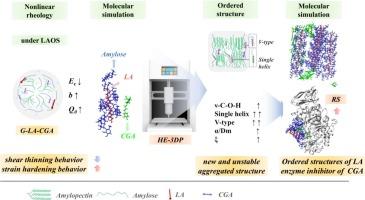淀粉-脂质-绿原酸三元体系中合理的相互作用可在热挤压 3D 打印过程中形成有序的抗消化淀粉结构:基于非线性流变学和分子模拟的研究
IF 5.4
2区 医学
Q2 MATERIALS SCIENCE, BIOMATERIALS
引用次数: 0
摘要
本研究采用非线性流变学和分子模拟技术,揭示了热挤压三维打印(HE-3DP)过程中小麦淀粉(WS)、亚油酸(LA)和绿原酸(CGA)之间的分子相互作用,并对其关键结构细节和消化率进行了相关讨论。综合结果表明,相互作用导致剪切稀化行为减弱,应变硬化贡献增加。此外,LA 通过疏水作用诱导 WS 腔形成单螺旋,而 CGA 则通过氢键促进 WS-LA 螺旋的连接,从而形成不稳定的聚集结构。值得注意的是,在 WS-LA-CGA 复合物中,II 型复合物峰的消失和 ξ 的增加表明其有序结构的密度较低。在消化过程中,稳定的淀粉-LA螺旋能降低与淀粉酶的结合能,而解离的CGA不仅能进一步降低结合能,还能通过氢键作用成为酶抑制剂,从而提高抗消化性。本文章由计算机程序翻译,如有差异,请以英文原文为准。

Rational mutual interactions in starch-lipid-chlorogenic acid ternary systems enable formation of ordered starch structure for anti-digestibility during hot-extrusion 3D printing: Based on the nonlinear rheology and molecular simulation
In this study, nonlinear rheology and molecular simulation were introduced to unravel the molecular interactions among wheat starch (WS), linoleic acid (LA) and chlorogenic acid (CGA) during hot-extrusion 3D printing (HE-3DP), and their key structural details and digestibility were relevantly discussed. The combined results showed the interactions led to weakened shear thinning behavior and increased contribution of strain hardening. Moreover, LA induced the WS cavity through hydrophobic interactions to form single helix, while CGA facilitated the connection of WS-LA helix through hydrogen bonding, resulting in the formation of unstable aggregated structures. Notably, the disappearance of type II complex peaks and increased ξ showed less dense ordered structures in WS-LA-CGA complex. During digestion process, the stable starch-LA helix could reduce the binding energy with amylase, while the dissociated CGA not only further lowered the binding energy, but also served as an enzyme inhibitor via hydrogen bonds interaction, thereby enhancing the anti-digestibility.
求助全文
通过发布文献求助,成功后即可免费获取论文全文。
去求助
来源期刊

ACS Biomaterials Science & Engineering
Materials Science-Biomaterials
CiteScore
10.30
自引率
3.40%
发文量
413
期刊介绍:
ACS Biomaterials Science & Engineering is the leading journal in the field of biomaterials, serving as an international forum for publishing cutting-edge research and innovative ideas on a broad range of topics:
Applications and Health – implantable tissues and devices, prosthesis, health risks, toxicology
Bio-interactions and Bio-compatibility – material-biology interactions, chemical/morphological/structural communication, mechanobiology, signaling and biological responses, immuno-engineering, calcification, coatings, corrosion and degradation of biomaterials and devices, biophysical regulation of cell functions
Characterization, Synthesis, and Modification – new biomaterials, bioinspired and biomimetic approaches to biomaterials, exploiting structural hierarchy and architectural control, combinatorial strategies for biomaterials discovery, genetic biomaterials design, synthetic biology, new composite systems, bionics, polymer synthesis
Controlled Release and Delivery Systems – biomaterial-based drug and gene delivery, bio-responsive delivery of regulatory molecules, pharmaceutical engineering
Healthcare Advances – clinical translation, regulatory issues, patient safety, emerging trends
Imaging and Diagnostics – imaging agents and probes, theranostics, biosensors, monitoring
Manufacturing and Technology – 3D printing, inks, organ-on-a-chip, bioreactor/perfusion systems, microdevices, BioMEMS, optics and electronics interfaces with biomaterials, systems integration
Modeling and Informatics Tools – scaling methods to guide biomaterial design, predictive algorithms for structure-function, biomechanics, integrating bioinformatics with biomaterials discovery, metabolomics in the context of biomaterials
Tissue Engineering and Regenerative Medicine – basic and applied studies, cell therapies, scaffolds, vascularization, bioartificial organs, transplantation and functionality, cellular agriculture
 求助内容:
求助内容: 应助结果提醒方式:
应助结果提醒方式:


